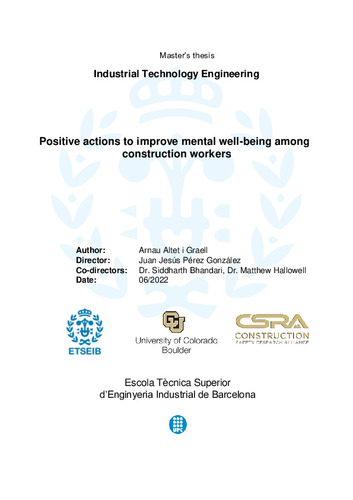Positive actions to improve mental well-being among construction workers
Realitzat a/ambUniversity of Colorado Boulder
Tipus de documentProjecte Final de Màster Oficial
Data2022-07-04
Condicions d'accésAccés obert
Tots els drets reservats. Aquesta obra està protegida pels drets de propietat intel·lectual i
industrial corresponents. Sense perjudici de les exempcions legals existents, queda prohibida la seva
reproducció, distribució, comunicació pública o transformació sense l'autorització del titular dels drets
Abstract
Construction workers are at a higher risk for mental health issues than every other profession. According to the Centers for Disease Control and Prevention, the construction industry is the second leading suicide rate, and nearly 25% of workers reported mental health problems in their last working month. Recent studies tried to identify the actual causes of this concerning data by putting together the more common stressors and coping strategies for construction workers. Moreover, some statistically valid relationships with depression and anxiety symptoms were pinpointed. Some leading construction companies are starting to spot the economic consequences of the workers’ mental well-being decrease. Nevertheless, the actual knowledge and resources to apply effective protocols are scarce, representing an additional barrier to mental health treatment. To address these shortcomings, this thesis firstly gathers all actual relevant information and calls it into question. All knowledge about work-related risk factors, common coping methods, and the stress appraisal process of the construction workforce is brought to light, compiling the state of the science. Secondly, the stage for employers that want to participate in employees’ mental health improvement is initiated. The future of workplace mental well-being includes a common effort of both employers and employees to address together these challenges, and finish with the loneliness that workers find when mental issues are manifested. This thesis pursues the objective to involve companies and resources by presenting a step- wise protocol to increase the awareness, measurement of crew mental health status, and efficient prioritization of resources. Keys for actions’ implementation, protocol evaluation, and apprenticeship are also introduced. Resource management and return on investment results are essential to involve stakeholders. Safety risk analysis and contingent viability modeling for safety are additionally explained thoroughly to lay the foundations of future mental health risk analysis. Having the crew motivated and pleased is socially and economically beneficial. The construction industry is lagging behind others in creating new work-friendly environments, that increase productivity and work satisfaction.
MatèriesMental illness, Construction workers, Mental illness--Treatment, Malalties mentals, Treballadors de la construcció, Malalties mentals--Tractament
TitulacióMÀSTER UNIVERSITARI EN ENGINYERIA INDUSTRIAL (Pla 2014)
Col·leccions
| Fitxers | Descripció | Mida | Format | Visualitza |
|---|---|---|---|---|
| thesis-arnau-altet.pdf | 1,726Mb | Visualitza/Obre | ||
| appendix1-arnau-altet.pdf | 636,1Kb | Visualitza/Obre |


